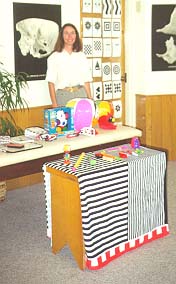What is a brain injured child?
Brain injury may be microscopic, or it may be global. It
may be recognized in disturbances of learning, of visual
perception or even of speech. But these are minor
disabilities in a generally healthy child. The global brain
injury resulting from illness in mother during pregnancy,
injury during a long or difficult birth or injury after
birth such as a car accident will reveal itself as major
disability. It may affect mobility; as for example spastic
cerebral palsy or language impairment or as a generalized
developmental delay of physical growth and activity and
mental or emotional delay.

What can we do for the brain injured child?
A developmentalist can provide you, the parent, with the
tools/activities and education to give your child the needed
sensory stimulation at the appropriate developmental
level.
Why is this important?
Movement is learning. It allows the brain to know where the
body is in relation to the world, it provides the
opportunity for increased experience of touch, vision and
hearing. A brain injury can create barriers that stifle this
process. Guidance in the form of patterning movements,
increased touch, visual, or hearing stimulation at the
correct
level can help reorganize these processes in the brain.
What is a healthy, disorganized child?
Neurological development within the brain occurs as a
result of interaction with the child’s environment.
Prone on the floor the baby begins the effort to crawl, army
style. When care givers talk to the baby about everything
all his waking hours he will begin to babble back and
progressively acquire language. A baby soon finds fingers
and toes
to play with but will then discover objects in the
environment to manipulate, to play with, to take apart, and
eventually reassemble. But for the child with some degree of
brain injury this interaction with the environment is
obstructed. The developmentalist provides techniques to
replace these deficiencies by various exercises such as
patterning to cultivate integrated arm, leg, head movement, visual
tracking of the eyes while maintaining a clear single visual
image whether at far or near and manual dexterity. Such
activities provide organized sensory input which stimulates
effective, integrated motor output. Minimal cerebral
dysfunction occurs in the child with very little if any
abnormality in the MRI. But this child may lack coordination
of walking, running or skipping. He may have difficulty
following a line of print from side to side or a column of
figures from above down or transcribing from the board to
his desk in school.
The developmentalist teaches the child by means of
sensory input - the child learns the sensation of crawling
and creeping, learns the sensation of tracking with the eyes
and learns the sensations that are perceived through the
skin moment by moment through the day. This stimulation
program known by the general term of patterning is taught to
the family to perform at home.
What can we do for the disorganized healthy
child?
There is no visible pathology in the brain, but this child
finds it difficult to receive, process, retrieve and use
information. There is a glitch in the integration necessary
for organized thought processes.
What can we do for the disorganized healthy child?
A developmentalist can provide you, the parent, with the
tools/activities and education to guide your child to live
in a more organized way. Recognition of visual, touch, or
hearing processing problems will help to design approaches
to learning that integrate all the senses so that there is
success in learning.
Why is this important?
If the process of thought is in a jumble because the path is
not even or complete, then it is difficult to get through
the day. Think of the thought process as climbing a ladder.
If a few rungs are missing or incomplete then it is far more
difficult to climb. It is important to integrate all our
senses so that we can perform our best.